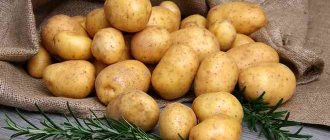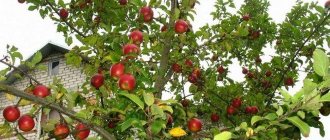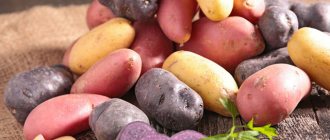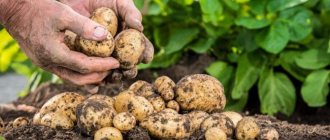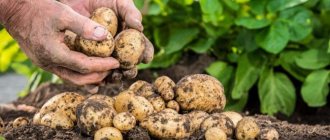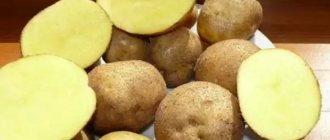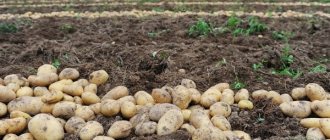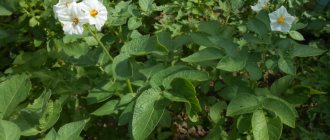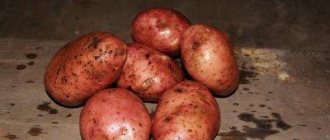The Lapot potato is an unconventional variety in all its senses. Firstly, this is a very large variety, which even the most elite breeding efforts can envy. Secondly, you will not find the creator of the variety, since he essentially does not exist. This variety comes from a people who first began to be cultivated in Siberia and the Far East. For this reason, people often call it the Siberian or Bashkir Laptem.
The first mentions of Lapta appeared in the 50s of the 20th century. But this does not indicate that the variety appeared precisely in those times. Many gardeners are still inclined to believe that Lapot was developed much earlier.
In the 20th century, the variety was very popular throughout the former USSR. However, today Lapot is practically not cultivated and can only be found in Transbaikalia.
The article will provide a description of the Lapot potato variety, reviews from gardeners and photos of this huge potato.
Characteristics of "Laptya"
Potato Lapot is a mid-early table variety. It stands out from other varieties due to its productivity indicators and incredibly large tubers.
It has the following characteristics:
- Tubers ripen 65-80 days after planting. The ripening period occurs in the second half of August/September (depending on the growing region).
- The bush is tall. The tops grow up to 60 cm.
- The bushes are spreading, the stems are intensively covered with leaves.
- The leaves are medium sized, light green in color.
- Lapot blooms with large white flowers. Flowering is abundant.
- The tubers are oblong in shape with flattened sides. Externally, potatoes look like old village bast shoes, which is where its name comes from.
- The shell is colored pink, the flesh is cream-colored.
- The percentage of starch in tubers is low, ranging from 12-14%.
- The eyes are superficial, few in number, and small in size.
- On average, one bush produces up to 8 large potatoes.
- The mass of tubers is usually 100-150 g. But there are specimens weighing 500 and even 600 g.
- The productivity of Laptya is phenomenal. From 1 hectare of plantings you can easily collect up to 500 centners.
- Root vegetables are universal, suitable for frying, boiling, and making purees.
- Keeping quality up to 94%. These are good indicators for mid-early potatoes.
- Lapota is not afraid of sudden climatic changes and responds adequately to short-term droughts, frosts and rains.
- The variety is not picky about the type of soil, but it is desirable that it be light, nutritious soil.
- The main weakness of the variety is weak immunity. The variety is often affected by Alternaria and late blight. It may also suffer from other fungal diseases.
Origin
Many agronomists are of the opinion that bast potatoes do not exist as a variety. In principle, this applies to almost all varieties of folk selection. They believe that these are simply wild cultivated varieties that have been grown in one area or another for a long time, and their official name has simply been forgotten. Agronomists believe that “bast” is one of the varieties bred in the USSR by crossing “Cuban” and “American”. Of course, during the process of long-term cultivation, the variety changed somewhat.
Positive and negative aspects of the variety
Despite the abundance of advantages, the variety is gradually forgotten. Among the positive qualities of Laptya, it is first of all worth noting:
- Huge tubers.
- Good taste.
- Tubers are not afraid of mechanical stress. Suitable for long distance transportation.
- Root vegetables are stored for a long time.
- The versatility of potatoes.
- The variety is not afraid of frost.
- Despite the fact that the variety was initially considered Siberian, practice has shown that it adapts perfectly to any climatic conditions.
At the same time, there are a number of disadvantages:
- The variety has very weak immunity, which is why it often suffers from various fungal diseases.
- Tubers are often attacked by wireworms.
- It is impossible to obtain high-quality seed material.
The last point is the most significant, since it is for this reason that the variety is so unpopular. Lapot is not included in the State Register of the Russian Federation; for this reason, the variety does not have an originator who is engaged in growing planting material. That is, it is simply impossible to buy Lapot potatoes in a nursery. Alternatively, it can be purchased from private traders, but often the quality of the planting material remains poor.
Spreading
The potato variety “bast” belongs to the varieties of folk selection. Today virtually nothing is known about its origins. The first mentions of this variety date back to the 50s of the last century. It has become widespread among gardeners in the Far East and Siberia. It has not lost its popularity to this day, although new domestic and foreign root crops are its competitors. “bast shoes” are often found in those regions that are called risky farming zones. Traditionally, these potatoes are grown by gardeners in Transbaikalia.
Correct fit
Lapota prefers to grow in an open area that is well ventilated and receives sufficient sunlight. Also, root crops cannot be planted in areas with close groundwater. The minimum area for their location is at least 70 cm below ground level.
The site is prepared for planting work in the fall. All weeds and crop residues are removed from the garden. Afterwards, the area is fertilized with manure (10 kg of fertilizer per 1 m2) and dug up. In spring, the soil is loosened and young weeds are removed.
Tubers are planted no earlier than the 20th of April. By this time, the soil is warming up to +9-10 degrees Celsius.
For planting, medium-sized tubers (about 70 g), without defects and with the largest number of eyes, are selected. Before planting, the tubers are germinated and treated with special chemicals to protect the crop from parasites and fungal diseases.
When planting, follow the standard scheme:
- Leave about 60-70 cm between the rows. This distance will make it easy to hill up the rows in the future and provide good aeration.
- Leave at least 35 cm between holes.
If the soil is fertile, then there is no need to feed it. If the soil is heavy or lacks nutrients, then during planting, wood ash or humus is added to the hole along with the tuber.
Caring for Laptem
Caring for potatoes is easy. In general, all care can be reduced to two procedures:
- For hilling.
- To watering.
Hilling
Speaking of hilling, this agrotechnical procedure allows you to saturate the soil with oxygen, remove weeds and promote the formation of new stolons (thanks to them, the yield increases by 20-30%).
Lapot is hilled twice during the growing season:
- When the tops became 20 centimeters.
- A few days before flowering begins.
Watering
Watering is the most important procedure. Potatoes only need to be watered 2-4 times per season. Twice - if the potatoes are not demanding on watering, 3 times - practically any variety is watered as standard, 4 times - if the variety is water-loving.
Bast shoes can be watered 2-3 times:
- After the sprouts appear (when they grow to 10-15 cm).
- A few days before flowering.
- Before it ends.
It is worth paying attention to the fact that it is not recommended to water Lapot after flowering. This is explained by the fact that after flowering the tubers begin to ripen and their immunity becomes vulnerable.
Peculiarities
This variety is notable for being suitable for planting in almost any type of soil.
The exception is soils containing a large number of mechanical elements; in their environment it will need additional feeding and care. The downside is the high dependence on water. Therefore, if you want to get a large and early harvest, then installing an automatic irrigation system would be a good solution.
Due to the characteristics of its fruits, it is perfect for both cooking at home and for growing for industrial purposes. Under the influence of heat treatment, it cooks perfectly and does not lose its pleasant color. Karatop is perfect not only for making regular purees, but also for making chips, and even for freezing.
Before planting, in order to achieve the best yield results, it is recommended to carefully select planting material (you should select only the largest tubers without any damage). It is also best to initially grow the plant in peat pots.
When planting material in the soil, it is better to place tubers of early-ripening varieties closer to each other. To feed Karatop, you should use those fertilizers that are well and quickly absorbed.
The reason for this is that all early-ripening potato varieties absorb nutrients much faster than their late-ripening counterparts.
IMPORTANT! During the ripening period, your plant will process beneficial minerals at double the rate, so during this time it will need additional watering and care. Karatop is one of the latest varieties bred by German agronomists
Cultivated in temperate climate zones, often grown in Russia, Moldova and Ukraine
Karatop is one of the latest varieties bred by German agronomists. Cultivated in temperate climate zones, it is often grown in Russia, Moldova and Ukraine.
The main features of the variety are:
- Precocity. The variety is considered early ripening, the vegetative period of which is 60-65 days. But, on the 50th day after planting, you can begin harvesting.
- Productivity. Karatop produces an excellent harvest, which at the first digging (45 days after planting) is 35 tons per hectare, and at the end of the ripening period it can reach 50-52 tons.
- Drought resistance. Potato Karatop reacts negatively to drought. In the absence of natural or artificial irrigation, tuber crops form more slowly, and the quality of the crop at the end of the growing season decreases.
- Undemanding to soils. Karatop feels great in almost all types of soil. But, in soils with heavy granulometric composition, it requires additional care and nutrition.
- Application. A table potato variety used both in home and industrial preparation. It tolerates long-term storage well, keeping quality is 97%. Suitable for germination and cultivation under film.
- Taste qualities. The taste of Karatop potatoes is rated 4.7 on a five-point scale. When cooked, it boils well and is perfect for making purees, chips, and also for freezing.
- Resistance to mechanical damage. Karatop tolerates mechanical damage well, with very minor damage.
- Disease resistance. The Karatop variety is famous for its high resistance to diseases and pests such as viruses A and Y, potato canker, nematode, glandular spot, and late blight of tops. Poor resistance to late blight of tubers was noted.
To compare the characteristics of Karatop with other potato varieties, pay attention to the table below:
| Variety name | Starch content | Keeping quality |
| Openwork | 14-16% | 95% |
| Desiree | 13-21% | 95% |
| Santana | 13-17% | 92% |
| Nevsky | 10-12% | good, but the tubers germinate early |
| Ramos | 13-16% | 97% |
| Taisiya | 13-16% | 96% (tubers have a long dormant period) |
| Lapot | 13-16% | 94% |
| Rodrigo | 12-15% | 95% (not subject to freezing) |
When it comes to storing potatoes, you only need to follow a few simple rules. We have prepared for you detailed materials about shelf life, the correct choice of location and storage conditions in winter.
Immunity
As noted above, Lapot is not the strongest variety.
We recommend reading: “Description of the potato variety Enchanter”
Potatoes are susceptible to the following diseases and parasites:
- Late blight. When infested by this fungus, the leaves, and then the shoots, become covered with dark spots. To prevent the crop from becoming infected with this disease, it is necessary to use only high-quality planting material and observe crop rotation.
- Alternaria blight. When infested by this fungus, characteristic dry spots appear on the leaves, and the tubers become covered with dark dents. As a preventive measure, special chemicals are used (planting tubers are treated with them).
- Wireworm. This insect digs tunnels in the tubers, which lead to rapid rotting. To prevent the pest from attacking the crop, it is necessary to promptly remove weeds (in particular wheatgrass). It is there that click beetles live, whose larvae are wireworms. It is also important to dig up the soil.
- Colorado beetle. This pest, together with its larvae, eats potato tops. To prevent the parasite from settling on the site, it is recommended to plant beans next to the crop.

